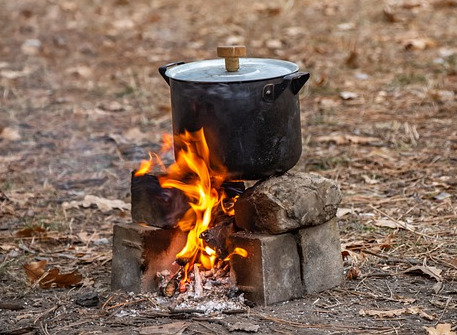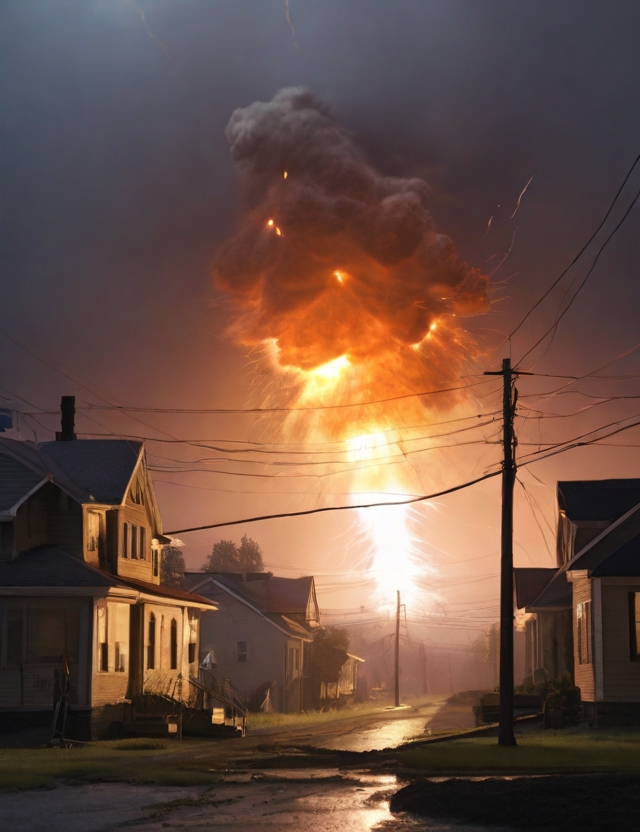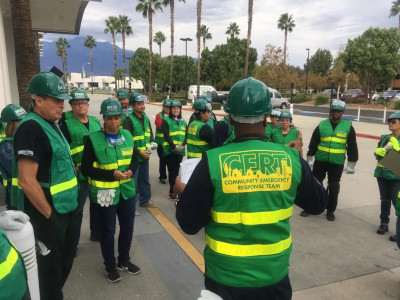Are You Prepared?
What if the electricity and gas were cut off for an extended period due to a natural disaster or social disruption? Assuming you have a supply of emergency food, would you know how to cook it?
This post details several ways you can feed your family hot meals even in a crisis situation.

Most indoor cooking methods burn fuel. Anytime you burn fuel indoors, there is a risk of carbon monoxide poisoning. Make sure you have adequate ventilation (even in winter).
Keep children and pets well away from open flames. Do not leave emergency cookers unattended.
Never burn charcoal, gasoline, or diesel fuel indoors! Wood and coal must be burned in a properly installed and vented stove or fireplace. The preferred fuels for indoor cooking are butane, propane, natural gas, and alcohol. Lamp oil, candles, chafing fuel, and kerosene are okay for indoor use but they tend to burn less cleanly. But any of these fuels can be dangerous if improperly used. Be sure to have a carbon monoxide detector and fire extinguisher nearby.
Indoor Cooking Ideas
Gas Camping Stove

Gas camping stoves run on canisters of butane, propane, or isobutene. Some can use alternative fuels such as gasoline in a pinch. But don’t use those alternative fuels indoors! For long-term preparedness, you’ll want a camping stove that can connect to a large propane tank. You can burn through a lot of little canisters in a hurry if you’re doing a lot of cooking or boiling your drinking water.
Alcohol Stove

Alcohol stoves burn very cleanly. But cooking with alcohol can be a bit tricky because it is hard to control the heat. Once they get the hang of it, though, many people prefer alcohol stoves over gas stoves. Be sure to use the type of alcohol specified by the manufacturer. Rubbing alcohol doesn’t burn cleanly, so it’s best to use that kind of alcohol outdoors.
Gelled Chafing Fuel

Also known as Sterno or canned heat, this fuel is made from alcohol turned into a jelly. As with an alcohol stove, it is hard to control the flame and heat. You will need to purchase or improvise a rack to hold your cooking pot. Chafing fuel is more expensive than alcohol, but it won’t evaporate like alcohol does, so it’s better for long-term storage.
Buddy Burner

Tea Light Oven

More properly called a Home Emergency Radiant Cooking (HERC) oven, a tea light oven is basically a closed metal box sitting above a bunch of tea light candles. It takes a long time, but you can make a tasty batch of cookies, a mean mac & cheese, or a hearty pot of stew in a tea light oven.
Wood Stove or Wood Fireplace

A wood stove or wood fireplace is a great way to both heat your home and cook during an emergency. Be sure the stove or fireplace is properly connected and vented. Invest in some sturdy cast iron cookware and utensils. For fireplace cooking, you will need a dripping pan to catch any grease. You might also want to install a gridiron, spit, and trivet.
Never try to cook on a gas fireplace. There is too much risk of carbon monoxide poisoning.
Outdoor Cooking Ideas
Barbecue Grill

Your BBQ grill is a decent option for cooking during power outages, but only if you cook outdoors. Why? Because BBQ grills – especially charcoal grills – emit huge amounts of carbon monoxide. Never use one indoors. Don’t even use one in a semi-enclosed place like a garage or covered patio.
Open Fire

Cooking on an open fire can be a lot of fun – at least when it isn’t raining or snowing! Ideally, let the wood burn down to coals and cook over those. It takes practice to cook well on an open fire – don’t be surprised if your first few pots of rice burn on the bottom. You can use a BBQ grill rack or rocks to support a pot or pan. Of course, you can always roast hot dogs or bread dough on sticks, or bake foil dinners on the coals.
Solar Cooker

A solar cooker captures the sun’s heat and focuses it on a container of food. There are literally hundreds of designs, from expensive high-tech parabolic reflectors to homemade foil-lined boxes. The advantage of a solar cooker is that it requires no fuel at all. But it only works when the sun is shining brightly, and it cooks very slowly on a cold day, so a solar cooker should not be your only option for emergency cooking.
Rocket Stove

A rocket stove is a small, efficient, portable woodburning stove that generates a lot of heat from twigs, bark, pine cones, etc. Many rocket stoves have clever designs that trap heat and make an intense flame without much wood. The pot stand is built in to make cooking easy. Some rocket stoves even come with attachments to convert excess heat into energy for charging USB devices.
Hobo Stove

With a large tin can, a juice can opener, some coat hanger wire, and a pair of tin snips, you can make a simple cookstove for free. (You can also buy hobo stoves online.) The hobo stove is a very basic wood stove fueled by sticks, twigs, etc. While not the most efficient cooker, this stove can be made simply using supplies most people have on hand. Many DIY hobo stove designs can be found online.
Dutch Oven

A longtime camping favorite, the Dutch oven is a big, heavy cooking pot made from cast iron. It works especially well with charcoal. Most Dutch ovens can even be set right on top of campfire embers. A Dutch oven needs to be “seasoned” to prevent cooked food from sticking, or you may find it impossible to clean. Lining the Dutch oven with aluminum foil can help. Dutch ovens are very versatile and can be used for baking, frying, boiling – just about any kind of cooking.
Earth Oven

An earth oven is exactly what it sounds like – an oven made from a mixture of dried earth and clay. It is fairly easy to build, and often cooks better than an outdoor brick oven. You can find instructions for building an earth oven online. Note: The entire structure needs to completely dry out before you use it; otherwise it can crack and crumble. In a humid climate the drying process can take many days or even weeks. Lining the bottom with fire bricks will help the oven cook hotter and more evenly.
Reflector Oven

A reflector oven is basically a metal box with a shiny inside surface that sits next to a campfire, reflecting the light and heat of the campfire onto a container of food on the interior rack. It takes a big campfire to make a reflector oven work.
Kerosene Stove

A kerosene stove consists of a fuel tank, a cooking surface, and one or more wicks that draw the fuel up from the tank. In addition to kerosene, many of these stoves can also burn diesel fuel or lamp oil. Kerosene stoves can pose a carbon monoxide risk, so it is recommended to use them outdoors.
Esbit Tablet Stove

An Esbit stove uses solid fuel pellets that burn very hot and last just about forever on the shelf. A single tablet burns for about 15 minutes and will boil a quart of water in about 8 minutes. You probably don’t want to use it with your best cookware, though – it will leave a nasty, hard-to-clean residue on the bottom of your pans.
We hope you have gotten some valuable ideas from this post. If you’re not prepared with emergency food and cooking facilities, we suggest you start today!



